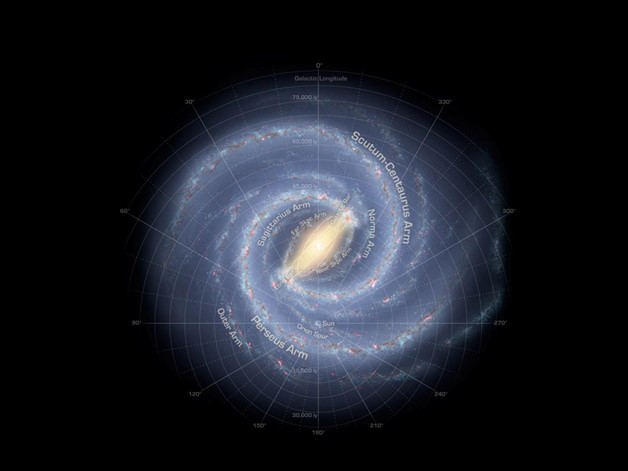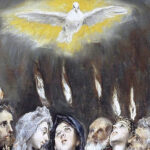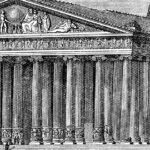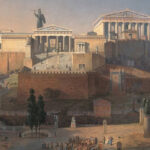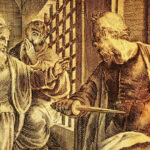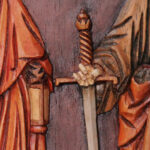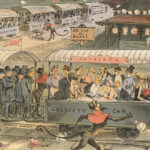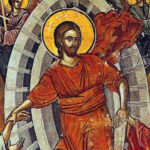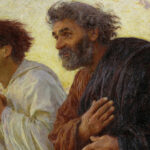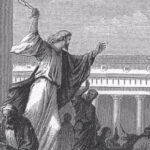Notes by Patrick G Mclaughlin
Part 1 – Cosmology (PDF)
Part 2 – Summary Notes for Chapter 5 (PDF)
Cosmology
cos·mol·o·gy
/käzˈmäləjē/
noun
- the science of the origin and development of the universe. Modern [evolutionary] astronomy is dominated by the Big Bang theory, which brings together observational astronomy and particle physics. –Oxford Electronic Dictionary
The Universe is all of space and time and their contents, including planets, stars, galaxies, and all other forms of matter and energy.
Genesis 1:1-5 . . . (KJV)
1In the beginning God created the heaven and the earth. 2And the earth was without form, and void; and darkness was upon the face of the deep. And the Spirit of God moved upon the face of the waters. 3And God said, Let there be light: and there was light. 4And God saw the light, that it was good: and God divided the light from the darkness. 5And God called the light Day, and the darkness He called Night. And the evening and the morning were the first day.
The Andromeda Galaxy, also known as Messier 31, M31, or NGC 224 and originally the Andromeda Nebula, is a barred spiral galaxy approximately 2.5 million light-years (770 kiloparsecs) from Earth and the nearest major galaxy to the Milky Way. The galaxy’s name stems from the area of Earth’s sky in which it appears, the constellation of Andromeda, which itself is named after the Ethiopian (or Phoenician) princess who was the wife of Perseus in Greek mythology.
Source: https://en.wikipedia.org/wiki/Andromeda_Galaxy (image and text)
Nota bene (from NASA): https://hubblesite.org/contents/news-releases/2015/news-2015- 02.html
The Milky Way is the galaxy that contains our Solar System, with the name describing the galaxy’s appearance from Earth: a hazy band of light seen in the night sky formed from stars that cannot be individually distinguished by the naked eye. The term Milky Way is a translation of
the Latin via lactea, from the Greek γαλακτικός κύκλος (galaktikos kýklos, “milky circle”).
Sources: “Astronomers Just Created an Awe-inspiring 3-D Map of the Milky Way” ([Milky Way Galaxy (Getty Images)], 1692×1142) www.salon.com;
“Milky Way” https://en.wikipedia.org/wiki/Milky_Way (text).
From Earth, the Milky Way appears as a band because its disk-shaped structure is viewed from within. Galileo Galilei first resolved the band of light into individual stars with his telescope in 1610. Until the early 1920s, most astronomers thought that the Milky Way contained all the stars in the Universe.
Sources: “Milky Way” https://en.wikipedia.org/wiki/Milky_Way (text)
“The Milky Way galaxy is probably much bigger than we thought” www.nbcnews.com (image, 1920×1080)
Psalm 19:1-2 – 1The heavens declare the glory of God; and the firmament shows forth His handiwork. 2Day unto day utters speech, and night unto night shows knowledge.
Romans 1:20 – 20For the invisible things of Him from the creation of the world are clearly seen, being understood by the things that are made, even His eternal power and Godhead; so that they [humankind] are without excuse:
The Solar System: The Solar System (and Earth) is located about 25,000 light-years to the galactic center and 25,000 light-years away from the rim. So basically, if you were to think of the Milky Way as a big record, we would be the spot that’s roughly halfway between the center and the edge.
Sources: “The Milky Way Galaxy” (NASA) https://solarsystem.nasa.gov/resources/285/the- milky-way-galaxy/ (image)
“Where [I]s Earth in the Milky Way? – Phys.org” phys.org › news › 2016-07-earth-milky (text)
CHAPTER 5: “The Evidence of Cosmology: Beginning with a Bang” (98- 130)
Strap in for the whirlwind tour of cosmology!
What questions came to mind as you read this chapter?
Before we go much further, someone please define “Cosmology” for us.
What is the fundamental Cosmological question: Where Did Everything Come From? (bottom, 98).
Genesis 1:1-5 . . .
“Fiat lux” (top, 99).
LS question: “How do scientific models and theories explain the origin of all? (top, 99). [In the limited time we have, that is what we are going to explore tonight.]
Steve Weinberg, The First Three Minutes (middle, 99) [simultaneous explosion everywhere (a sudden burst of energy exemplifying the magnificently creative force of God).]
What did Steve Weinberg have to say early on in the chapter, and how does it help confirm our faith in the Genesis 1 account? “‘The universe . . . was filled with light'” (bottom, 99).
Bill Bryson, A Short History of Nearly Everything: What caused the universe to suddenly spring into existence? (bottom, 99)
Edward Milne (middle, 100)
Interview # 3: William Lane Craig, PhD., ThD.; [bachelor’s degree in communications from Wheaton College (1971); master of theology degree in philosophy of religion at Trinity Evangelical Divinity School (1975); doctorate in philosophy at the University of Birmingham, England (1977, studying with John Hick); awarded a postdoctoral fellowship in 1978 from the Alexander von Humboldt Foundation to pursue research on the historicity of the resurrection of Jesus under the direction of Wolfhart Pannenberg at the Ludwig-Maximillians- Universität München in Germany–which led to a second doctorate in theology (1984); Professor of Philosophy at Houston Baptist University (2014-present) and Research Professor of Philosophy at Talbot School of Theology (Biola University, 1994-present)] (middle, 101-102). Craig’s credentials and publications (bottom, 101-top,102).
“Christianity can stand up to rational analysis and rugged scrutiny” [and so can the doctrine of Creation] (Case for Christ, top, 225; Case for a Creator, very bottom, 115).
“The Kalam Cosmological Argument” (bottom, 102-top 104). [What follows in most of the rest of the chapter details the steps in the argument.]
al-Ghazali (middle, 103)
[LS] “‘What does kalam mean?'” (bottom, 102) [“speech” or “doctrine”–a system of “‘philosophical and mathematical reasoning'” (bottom, 103).Three major arguments for the existence of God:
Cosmological–Existence [because things exists, there must be a First Cause; everything that comes into being has a cause.]
Ontological–Being [Anselm]
Teleological–Design or Purpose [William Paley]
Three simple steps to the Kalam argument: Whatever begins to exist has a cause.
The universe began to exist.
Therefore, the universe has a cause.
“Step # 1: Whatever Begins to Exist Has a Cause” (middle top, 104-bottom, 107).
Quentin Smith (middle, 104).
[WLC] The first premise is “‘intuitively [directly and immediately known by the mind] obvious” [. . .] concept of absolute nothingness”‘ (top, 105).Quantum physics to the rescue [or not]! (bottom, 105).
Timothy Ferris (very bottom, 105).
Is the Universe a Free Lunch? (top, 106-bottom, 107)
Edward Tryon (middle, 106). [vacuum fluctuation, virtual particles.]
Vacuums are not places of pure nothingness; consider the vacuum of outer space (bottom, 106).
Infinite regress (top, 107).
Something transcendent is required [something outside the system] (middle top, 107).
David Hume [1754], the skeptic’s skeptic (middle, 107)
“Step # 2: The Universe Had a Beginning” (bottom, 107-113)
[LS] “‘How do we really know that the universe started at some point in the past?'” (top, 108). [WLC] Two pathways to answer LS’s question (Top middle, 108).The Pathway of Mathematics [or Philosophy] (middle 108-bottom, 110)
[Impossible to have an infinite past] transfinite arithmetic (middle, 108)In mathematics, transfinite numbers are numbers that are “infinite” in the sense that they are larger than all finite numbers, yet not necessarily absolutely infinite. These include the transfinite cardinals, which are cardinal numbers [1, One] used to quantify the size of infinite sets, and the transfinite ordinals, which are ordinal numbers [1st, First] used to provide an ordering of infinite sets. The term “trans- finite” was coined by Georg Cantor in 1915, who wished to avoid some of the implications of the word “infinite.”
WLC marble example: “losing one’s marbles” (bottom, 108-middle, 109).
Why are “‘mathematicians [. . .] forbidden from doing subtraction and division in transfinite arithmetic[?]'” (middle, 109).
Properly defining God (middle, 110).
The Pathway of Science (very bottom, 110-bottom, 113)
What shocking discovery did Albert Einstein’s make in 1915, based on his formulating of the General Theory of Relativity? (top, 111).
What were the three main discoveries scientists made based on the hypothesis of the “Big Bang”? (middle, 111-top, 112).
- Alexander Friedman and George Lemaître [1920s]: “[P]redicted the universe was expanding” (top middle, 111).
Fred Hoyle–derisively [ridicule or scorn to show contempt] called this the “Big Bang,” and it stuck (top middle, 111). [Remember that the next time you are on Jeopardy, and you might win some big bucks!]
Edwin Hubble [1929]: “Red shift–first empirical confirmation of F’s & L’s prediction” (middle, 111).
- George Gamow predicted [1940s]: “‘[T]he background temperature of the universe should be just a few degrees above absolute zero'” [1965, about 7 degrees above absolute zero (-273.15° on the Celsius scale (International System of Units), which equals -459.67° on the Fahrenheit scale (United States customary units or Imperial units).)] (bottom middle, 111).
- “The origin of the light [that is, by atomic number] elements [deuterium (do-
‘tear-re-um, an isotope of hydrogen–has 2x the mass of ordinary hydrogen) and helium provides evidence for the Big Bang (bottom, 111-top/middle, 112).
Inflation theory (middle, 112-middle, 113).
What in the world is a “singularity”? (middle, 113).
Stephen Hawking: “‘”Almost everyone now believes that the universe, and time itself, had a beginning at the Big Bang”‘” (bottom, 113).
“Step # 3: Therefore, the Universe Has a Cause” (top, 114-top, 116)
Thomas Aquinas and hubris [I didn’t realize what a cheeky guy T.A. was!] (top, 114)
Kai Nielsen (middle, 114) Creation ex nihlio.
Robert Jastrow “‘flash of light and energy'” (middle bottom, 114).
[LS] “‘What specifically can you deduce about this cause'” (bottom, 114). [WLC] QED [quod erat demonstrandum; or interestingly, quantum electrodynamics] (very bottom, 114).QED [literally meaning “what was to be shown.” Traditionally, the abbreviation is
placed at the end of a mathematical proof or philosophical argument in print publications to indicate that the proof or the argument is complete, and hence is used with the meaning “thus it has been demonstrated.”
A classic fallacy in logic: George Smith and David [M.] Brooks (top, 115).
What is Ockham’s razor? (middle, 115). [English Franciscan theologian, William of Ockham, d. 1349] (Alternatively, the simplest of competing theories is to be preferred to the more complex or that explanations of unknown phenomena be sought first in terms of known quantities.)
Jesus–historicity (very bottom, 115).
The Personal Creator (top, 116-18)
Is the First Cause personal or not?
George Smith reprise (top middle, 116).
[WLC] Two types of explanations. How do they differ? (middle, 116). [WLC] Boiling kettle example (bottom, 116).What are the three reasons WLC gives for why the cause of the universe has to be personal? (top/middle, 117).
- The cause of the universe must be an agent, who has volition to create it.
- The cause must transcend time and space, which makes it timeless and
- The cause must not be subject to physical laws, and thus must have free will.
What are the two types of entities that can be timeless and immaterial? [abstract objects (numbers or mathematical equations) and mind] (middle, 117).
Edmund Whittaker puts it succinctly (very bottom, 117-top, 118)
The First Cause is above the laws of nature (middle, 118).
Alternatives to the Big Bang (top, 119-middle, 120)
Eddington, Morrison, Jastrow quote (top middle, 119). [Losing control]
Steady State theory [1948] (bottom, 119). [violates the First Law of Thermodynamics
Sir Fred Hoyle reprise (top, 120).
Stephen C. Meyer reprise (top, 120).
[WLC] “‘[S]cientists are not mere thinking machines but are driven by philosophical and emotional factors as well'” (top middle, 120).Exploring Sagan’s Cosmos (bottom middle, 120-bottom middle, 124)
Oscillating Model of the universe [1960s] (bottom, 120).
What are three problems with the Oscillating Model of the universe? (121).
Joseph Silk (bottom, 121)
String theory (middle, 122)
[WLC] “‘This cyclic scenario is plagued with problems [three, actually]”‘ (very bottom, 122-top, 123)Alan Guth [2001] (top, 123)
André Linde and “chaotic inflation” (middle, 123)
Edward Tryon’s quantum model “baby or toddler universes bumping into one another” (top, 124)
Hawking’s Challenge (bottom, 124-middle, 126)
Stephen Hawking went to his eternal reward on March 14, 2018.
His God is too small (middle, 125).
[WLC] Drawing a model of the Big Bang (bottom, 125-top, 126).The World of Imaginary Numbers (bottom, 126-bottom, 128).
[WLC] “‘I think he [Hawking] has made a philosophical error by thinking that having a beginning entails having a beginning point”” (bottom, 126).Did you ever have any imaginary friends as a child, and were any of them
imaginary numbers?
How Hawking’s model has a beginning (very bottom, 126).
How did Hawking achieve his rounding-off effect, which is key to his model?
‘”[H]e is only able to achieve this [. . .] by substituting “imaginary numbers” for real numbers in his equations'” (top, 127).
Apt metaphor (middle, 127).
What did Hawking concede? (middle bottom, 127).
“‘But the hypothesis that God raised Jesus from the dead doesn’t contradict science or any known fact of experience. All it requires is the hypothesis that God exists, and I think there is good independent reasons for believing that [H]e does'” [The Case for Christ, top, 242] (Cf. The Case for a Creator, bottom, 115).
How have the tables turned over the years in this debate (bottom, 127-top, 128).
Physical Laws, Spiritual Laws (bottom, 128-30)
WLC’s personal testimony of witnessing with his wife Jan (bottom, 128-130).
Eastern European female physicist’s conversion (bottom, 128-130).
Segue to the next chapter–examining the laws of physics (bottom middl



